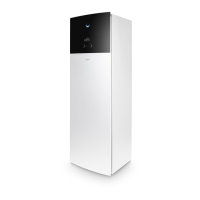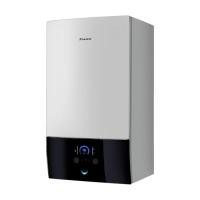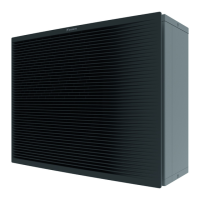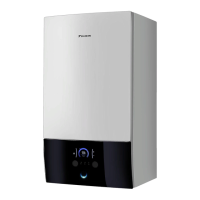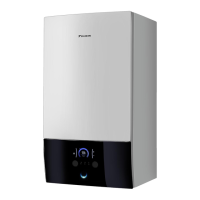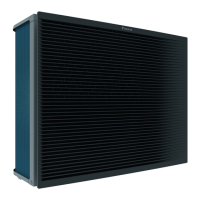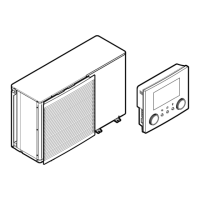
Do you have a question about the Daikin Altherma 3 M Series and is the answer not in the manual?
| Type | Air-to-water heat pump |
|---|---|
| Refrigerant | R-32 |
| Energy Efficiency | A+++ |
| Heating Capacity | 4.0 - 16.0 kW |
| Cooling Capacity | 3.5 - 14.0 kW |
| Operating Temperature Range (Heating) | -25°C to 35°C |
| Operating Temperature Range (Cooling) | 10°C to 46°C |
| Sound Power Level | 58 - 62 dBA |
| Sound Pressure Level (Outdoor Unit) | 47 - 49 dBA |
Explains reading the manual and target audience for understanding the system's performance.
Lists other related documents within the complete documentation set for comprehensive information.
Covers electrical safety, handling of materials, and environmental considerations for safe operation.
Specific warnings and instructions for operating the unit safely to prevent hazards.
Describes the typical system components and their arrangement in a diagrammatic layout.
Explains different user access levels and the procedure to change them via the user profile.
Instructions for turning space heating/cooling ON/OFF and adjusting the desired room temperature.
How to read out and adjust the desired leaving water temperature for heating or cooling.
Steps to modify the weather-dependent curve settings for space heating/cooling zones.
Procedures to activate or deactivate the domestic hot water tank heating operation.
How to view and adjust the desired domestic hot water temperature setpoint.
Describes the LCD screen, dials, buttons, WLAN slot, and USB connector for system interaction.
Details settings for room, main zone, and additional zone operations like schedules and setpoints.
Details settings for the tank, user preferences such as language and time, and information display.
Covers operation modes, user profiles, and wireless gateway settings for system control.
Explains the layout and information displayed on the home screen, including temperatures and date/time.
How to access different screens and submenus from the main menu using the left dial.
Illustrates various setpoint screens for different functions like room temperature and leaving water temperature.
Explains how to view detailed system settings and values using the dials.
Procedures to enable or disable space heating/cooling and tank heating operations.
How to select heating, cooling, or automatic modes for space conditioning.
Restricting automatic mode changes based on a monthly schedule for optimized operation.
Steps to modify the target room temperature, considering scheduled actions.
Describes how the reheat mode functions to maintain DHW temperature, potentially interrupting other functions.
Explains the scheduled mode for DHW production, optimizing heating based on demand and time.
Details the combined scheduled and reheat modes, ensuring minimum hot water availability.
How to check and activate powerful operation for rapid DHW heating when needed.
How to remove existing schedule content for specific days or the entire week.
Steps to set up a room temperature schedule for optimized heating or cooling.
Instructions for replicating programmed schedules across different days of the week.
How to assign a new, custom name to a programmed schedule for easier identification.
Explains the concept, advantage, and availability of weather-dependent curves for energy efficiency.
Differentiates between 2-points and slope-offset curve types for temperature adjustment.
How to set up a 2-points curve by defining two specific temperature setpoints.
How to set up a slope-offset curve by adjusting slope and offset parameters.
How to enable weather-dependent operation by selecting the correct setpoint mode.
How to switch between the 2-points and slope-offset curve types for different zones.
Detailed guidance on adjusting slope and offset for optimal performance at various temperatures.
Tips to reduce energy consumption by managing room temperature settings effectively.
Tips to save energy by adjusting DHW tank temperature and usage schedules.
Information on yearly maintenance requirements and finding installer contact details via the interface.
How to view error codes and detailed descriptions for system malfunctions.
Accessing a log of past malfunctions to identify recurring issues.
Solutions for issues where the room is too cold or too hot, including setpoint and schedule adjustments.
Solutions for problems related to cold tap water, such as adjusting tank temperature or schedules.
Troubleshooting steps and considerations for heat pump operational failures.
Guidelines for environmentally sound disposal of the unit, emphasizing specialized treatment facilities.
Definitions of key terms used throughout the manual, such as DHW and LWT.
Settings related to the initial system configuration and setup performed by the installer.
A summary of available settings accessible via the menu, categorized by system component.


